October 31 - November 7, 2001
The Big Travelogue: Part Ten
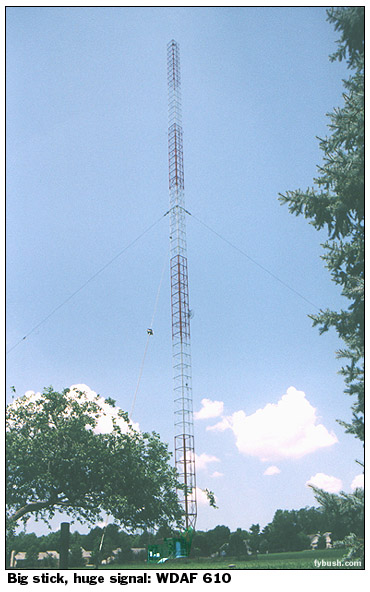 There's
nothing like a good road trip to get a feel for the state of
radio these days. From June 23 until July 7, your editor (accompanied
by Boston Radio Archives creator Garrett Wollman) hit the road
to see what's on - and in - the air across a broad swath of mid-America. There's
nothing like a good road trip to get a feel for the state of
radio these days. From June 23 until July 7, your editor (accompanied
by Boston Radio Archives creator Garrett Wollman) hit the road
to see what's on - and in - the air across a broad swath of mid-America.
For the next few installments of Site of the Week, we'll be
recapping the many highlights of what we like to think of as
The Big Trip, 2001 edition. Come along...
Click
here for part one
Click
here for part two
Click
here for part three
Click
here for part four
Click
here for part five
Click
here for part six
Click
here for part seven
Click
here for part eight
Click
here for part nine
Tuesday, July 3 - We're well past the halfway point
of our journey chronologically, and now we've reached the halfway
mark geographically. From our morning in Topeka, the rest of
our trip will take us eastward, towards home - but with so much
more to see in the five days before our return to Rochester.
 So it's on to the
Kansas Turnpike we head, getting off 30 miles or so later in
the college town (University of Kansas, to be precise) of Lawrence. So it's on to the
Kansas Turnpike we head, getting off 30 miles or so later in
the college town (University of Kansas, to be precise) of Lawrence.
There's not a great deal of radio to see here; local AM KLWN
(1320) has a single, unexciting stick near the K-10 bypass on
the southwest side of town, while the university's public radio
KANU (91.5) and student-run KJHK (90.7) have sticks on the campus.
Lawrence's commercial FM station, KLZR (105.9), has long been
a rimshotter targeting the much larger Kansas City market some
25 miles away, but its studios remain in Lawrence, on West 6th
Street (aka US 40). A quick dash into the lobby finds a rotating
postcard rack chock-full of KLWN and KLZR stickers, and we obtain
samples for the collection.
The K-10 freeway delivers us into the Kansas City metro area
by way of the southwestern suburb of Olathe, Kansas, where we
make a quick stop for a newspaper (noting the tower of religious
KCCV-FM 92.3 alongside K-10 just before it approaches the merge
with the I-435 loop and I-35 itself), then head on to the big
show of the day.
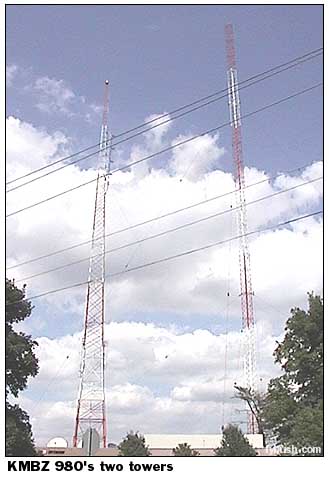 I-435
heads east, and we hop off at the State Line Road exit, heading
north - but not quite ready to leave Kansas behind. A left on
Somerset and a mile west to Mission Road, and we're at the mighty
stick that graces the top of this week's page. WDAF is a heritage
station if ever there was one (just look at the old "W"
call that predates the redrawing of the W/K line along the Mississippi
River!), running 5 kW day and night, non-directional, from that
big square-faced tower just south of W. 79th Street. Those 5
kilowatts way down at 610 on the dial get out better than a lot
of 50,000 watters we've heard! I-435
heads east, and we hop off at the State Line Road exit, heading
north - but not quite ready to leave Kansas behind. A left on
Somerset and a mile west to Mission Road, and we're at the mighty
stick that graces the top of this week's page. WDAF is a heritage
station if ever there was one (just look at the old "W"
call that predates the redrawing of the W/K line along the Mississippi
River!), running 5 kW day and night, non-directional, from that
big square-faced tower just south of W. 79th Street. Those 5
kilowatts way down at 610 on the dial get out better than a lot
of 50,000 watters we've heard!
(It was probably a more impressive sight twenty or so years
ago, before a townhome development was built right up to the
edges of the guy wires, but it's still something to see...)
Now we're ready to cross into Missouri, if only to find a
good restaurant in the Country Club Plaza area (we do) and get
out of the hot sun (it's in the nineties again) for a leisurely
lunch and a chance for some aircheck tapes to roll in the car.
After lunch, it's back to the Kansas side, along US 56 (Shawnee
Mission Parkway), turning off just across the state line on Belinder
Road for a stop at another big site.
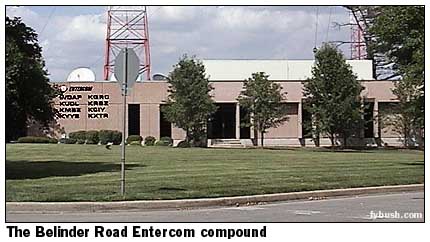 This building at
4935 Belinder Road used to house just two radio stations: KMBZ
(980), whose two towers are out back, and its sister FM, KMBR
(99.7). This building at
4935 Belinder Road used to house just two radio stations: KMBZ
(980), whose two towers are out back, and its sister FM, KMBR
(99.7).
That was before clustering - and today, 4935 Belinder accomodates
eight Entercom stations. In addition to KMBZ and the 99.7, now
KYYS (the heritage calls that used to be on 102.1, now KSRC.,
which is also here), this building houses WDAF radio, KUDL (98.1),
KRBZ (96.5), KCIY (106.5) and KXTR (1660).
A few quick historical notes: KMBZ is the former KMBC(AM),
and those heritage calls live on at KMBC-TV, channel 9 (we'll
look at that station next week when we do the FM and TV facilities);
the KXTR calls and classical format had a long history at 96.5,
until that family-owned facility was sold a few years back. Entercom
has tried to maintain at least a vestige of the old KXTR, putting
the format and calls first on AM 1250 (which was moved into the
Kansas City market from Topeka after decades in that city as
WREN, with a long-defunct sharetime at the university in Manhattan),
then on the X-band facility at 1660. 1250 is now KWSJ, a leased-time
Spanish-language outlet; we won't make it to the tower site it
shares with KGGN (890 Gladstone) northeast of town.
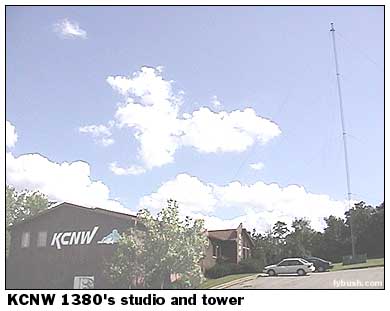 After Belinder Road,
we head west on Shawnee Mission Parkway (past the KCTV-5 studios,
which we'll feature next week) and north on I-35 to I-635. After Belinder Road,
we head west on Shawnee Mission Parkway (past the KCTV-5 studios,
which we'll feature next week) and north on I-35 to I-635.
(First, though, we stop near the Shawnee Mission/35 interchange
at 6230 Eby Drive, which our historical maps show as the 1970s-era
home of KUDL-FM 98.1 and its then-AM sister at 1380. A tower
here was apparently KUDL-FM's home back then as well; today it
carries cellular antennas and such, and is owned by American
Tower.)
Jumping off 635 just before we cross the Kansas River, we
find the current home of AM 1380. KCNW is the callsign now, and
the station is licensed to Fairway, Kansas, where it runs a religious
format from its single tower on Metropolitan Avenue, just west
of the highway.
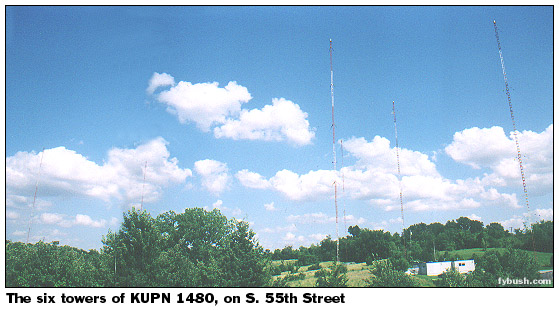
Just a mile away, we find one of Kansas City's more dramatic
sites: the six towers of the station now known as KUPN, licensed
to Mission and running a Spanish-language format.
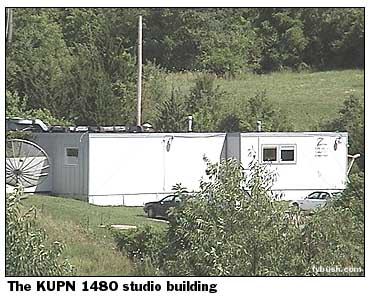 A long driveway
leads off S. 55th Street down to the studio building, nestled
next to three of the sticks - quite possibly the three that are
used for the station's 1000-watt daytime operation, which sends
a teardrop-shaped pattern to the east-southeast. A long driveway
leads off S. 55th Street down to the studio building, nestled
next to three of the sticks - quite possibly the three that are
used for the station's 1000-watt daytime operation, which sends
a teardrop-shaped pattern to the east-southeast.
The two towers to the left of the picture (the north side
of the property), along with the one in the middle and (I think)
one of the three day towers form a parallelogram for the 500-watt
night signal, aimed mainly to the south-southeast.
As we're parked on the driveway taking pictures, a woman leans
out the door down below to ask us what we're up to; we're not
quite sure she believed our explanation!
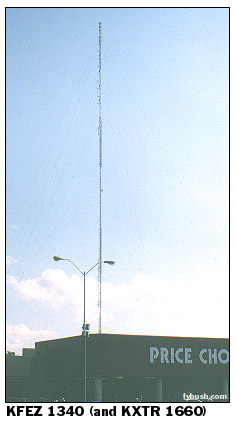 In any
case, a quick jog back to 635 and over the river soon takes us
to the interchange with US 24 (State Avenue), which is graced
by a tall tower with some old FM bays. In any
case, a quick jog back to 635 and over the river soon takes us
to the interchange with US 24 (State Avenue), which is graced
by a tall tower with some old FM bays.
The bays, it turns out, are the former site of KFKF-FM (94.1),
and the stick itself is still used by KFKF's former AM sister,
the station on 1340 that's been KCKN, KFKF(AM), KNHN and now
KFEZ.
For years, this station's history has been tangled with the
station on 1190 known variously as KJLA, KFEZ and now KPHN. At
the base of the tower, behind the supermarket, an abandoned building
still shows signs of both stations' histories; peer closely at
the sign in front and you can make out the CNN logo from 1190's
days as a CNN Headline News relay.
This tower has another occupant these days: this is where
the KXTR 1660 facility operates, serving Kansas City with classical
music programmed back in Boston at the WCRB facilities. (There's
something wrong with the automation this week; the station is
alternating between long stretches of dead air and music!)
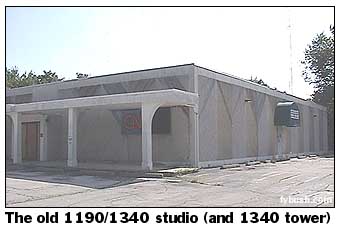 From here, we follow
US 24 into downtown Kansas City, Kansas, a community that's unquestionably
seen better days, then over the bridge on I-70, into the tangled
mess of highway that surrounds the heart of downtown Kansas City. From here, we follow
US 24 into downtown Kansas City, Kansas, a community that's unquestionably
seen better days, then over the bridge on I-70, into the tangled
mess of highway that surrounds the heart of downtown Kansas City.
We'll cover this part of the trip in much greater detail next
week, since it encompasses the major TV and FM sites, not to
mention a freeway exit improbably marked "Exit 2Y"
- but suffice it to say we end up pointed north on I-29 and US
169, exiting at Cookingham Road just before 169 crosses the northern
end of the I-435 loop. (We're in extreme northern Kansas City
here, past a big chunk of rural land that was apparently annexed
to the city to connect it to the airport.)
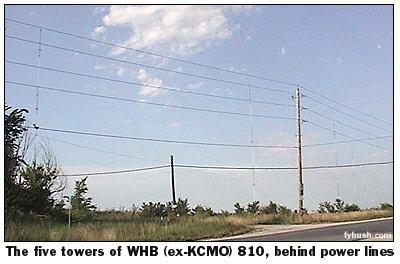 It's here that we
see Kansas City's only 50,000 watter, the 810 kHz signal known
for most of its life as KCMO. It's here that we
see Kansas City's only 50,000 watter, the 810 kHz signal known
for most of its life as KCMO.
By day, this is a non-directional 50 kW blowtorch; at night,
it takes five towers and 5 kilowatts to produce a figure-eight
pattern aimed to the north-northwest and south-southeast to protect
WGY and KGO on the coasts.
As you can make out (just barely, to be sure; this is a tough
array to get a good picture of), the five towers include three
in a row behind the old brick transmitter building and two more
spaced widely to the west.
 That's quite a building,
isn't it? We've seen pictures that show it in its heyday, when
the huge letters above the door still clearly spelled out "K
C M O," now represented only faintly in the brick (look
very closely and you might see it!) That's quite a building,
isn't it? We've seen pictures that show it in its heyday, when
the huge letters above the door still clearly spelled out "K
C M O," now represented only faintly in the brick (look
very closely and you might see it!)
Why no calls? A couple of years ago, Entercom traded this
signal for the 710 kHz facility long known as WHB. The idea was
to give WHB, then running a farm format, the wide coverage of
810's day signal, while giving news-talk KCMO the superior 5
kW night coverage on 710. A useless bit of trivia that resulted
(thanks to Mark Durenberger for noticing this one): All three
50,000 watt stations on 810 now bear three-letter calls.
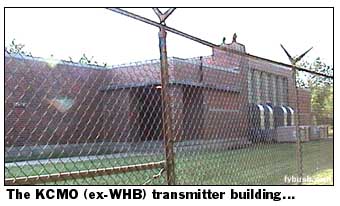 Heading east on Cookingham,
across the northeast corner of the 435 loop and north on Eastern
brings us to that 710 facility, another five-tower array. Heading east on Cookingham,
across the northeast corner of the 435 loop and north on Eastern
brings us to that 710 facility, another five-tower array.
We've seen old pictures of this transmitter building before,
too, so we know that the roofline of the tall part of the building
once continued to the right, framing big "W H B" letters
made of stainless steel. It looks like those disappeared long
before the WHB calls left this building...
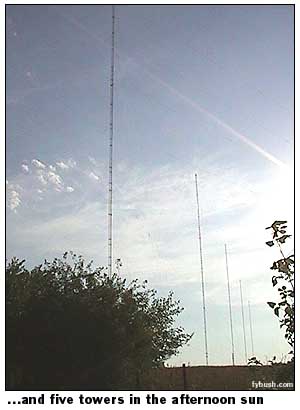 This is another
tough one to get a picture of, largely because it's late in the
day and we're looking west, directly into the sinking sun. This is another
tough one to get a picture of, largely because it's late in the
day and we're looking west, directly into the sinking sun.
These five towers are arranged roughly on a southeast-northwest
axis, using 10 kW by day and 5 kW by night to generate a figure-eight
with major lobes broadside to the array and nulls towards other
710 signals in places like Shreveport and Seattle.
The I-435 loop takes us south again, not far from that 1250/890
array that we don't have time to see (we're told it's hard to
get to by road, anyway) and over to our motel in Independence,
where we set up the VCRs to capture Kansas City's TV news, cool
off with a quick swim, and then head back into Kansas City for
one of the culinary highlights of the trip: the legendary barbecue
at Arthur Bryant's (special thanks to Mark Roberts and Sandy
Smith for weighing in on the vital "where should we eat?"
question!)
The food is great, and keeps us sustained for a speedy drive
back to Topeka to retrieve the box of tapes we realize we've
accidentally abandoned at the previous night's hotel. (Oops!)
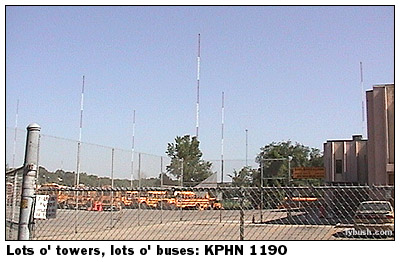 Wednesday,
July 4 - Our Independence Day begins here in Independence
with a drive back into Kansas City to catch a few sites we'd
missed the day before - mostly TV and FM sites, but with a few
AMs mixed in. Wednesday,
July 4 - Our Independence Day begins here in Independence
with a drive back into Kansas City to catch a few sites we'd
missed the day before - mostly TV and FM sites, but with a few
AMs mixed in.
Just south of I-70 near the I-435 interchange, we find the
six towers of KPHN (1190), north of 35th Street behind a school
bus garage.
This site puts out a 5000 watt non-directional signal by day,
dropping to 1000 watts during critical hours - and then fading
down to just 250 watts from all six towers at night to protect
all those other 1190 stations in places like Portland, Dallas,
Guadalajara -- and, yes, Fort Wayne. (KPHN will likely be able
to boost power or alter its pattern now that WOWO has been downgraded
to class B status. Thanks, WLIB!)
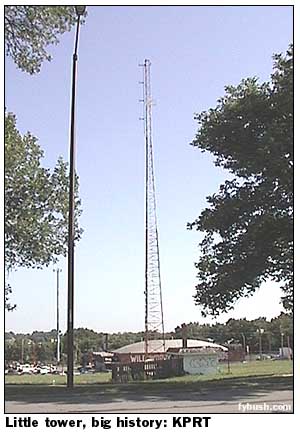 One more site completes
our AM tour of Kansas City, and it's nothing you'd look twice
at, unless you know the history. One more site completes
our AM tour of Kansas City, and it's nothing you'd look twice
at, unless you know the history.
KPRT cranks out 1000 watts by day from this little stick on
Linwood between Myrtle and Norton, dropping down to 46 watts
at night on 1590.
Why do we care? Under its old call of KPRS, this little signal
was the Carter family's original station in Kansas City, beginning
a history of black-owned community radio here that's now in its
fifth decade.
The KPRS calls moved to 103.3 FM decades ago (that's an old
set of 103.3 bays on the side of the 1590 stick), and today the
Carters program R&B on the FM and gospel on the AM, and regularly
sit atop the ratings in their hometown, still with plenty of
community involvement and responsiveness.
From here, our journey takes us east again to the Truman home
in Independence, and then across Missouri to Columbia - but we'll
get there (as well as stopping at Kansas City's FM and TV facilities)
in part eleven, next week...
Meanwhile...you can still enjoy the Big Trip's lovely
KFAB view and eleven more favorites from Tower Site of the Week
all year long, if you order the Tower Site 2002 Calendar!
This full-color, 8.5-by-11 inch, glossy calendar features a dozen
exciting tower images, and it can be on your wall for just $15,
postpaid! (NY residents include sales tax; US$20 postpaid to
Canada).
You can have yours for the holidays - and our ordering deadline
has been extended, so it's not too late to send your check or
money order, payable to Scott Fybush (that's me), to 92
Bonnie Brae Ave., Rochester NY 14618.
Your purchase of a calendar helps keep Site of the Week coming
all year round...thank you!
|
